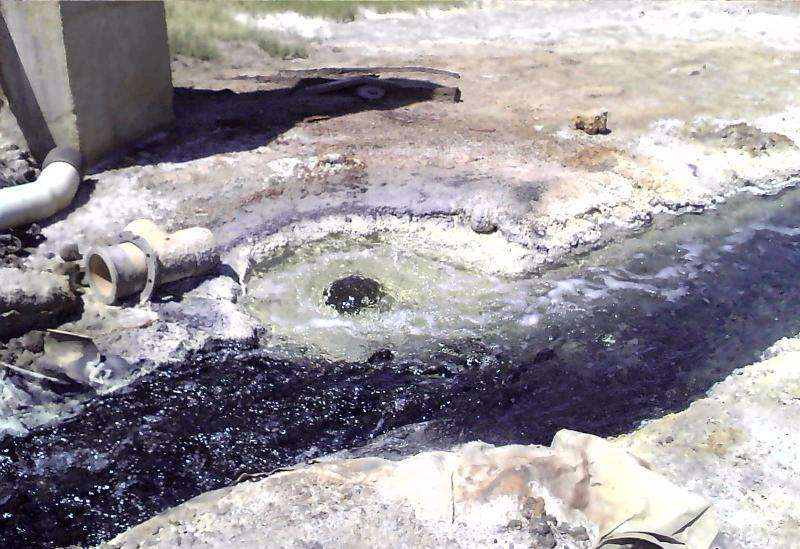Brackish artesian well in Pecos County. Credit: Texas A&M AgriLife Extension Service photo by Dr. Alyson McDonald
Even with the downturn in the oil patch, interest in brackish groundwater remains high across West Texas, a Texas A&M AgriLife Extension Service range expert said.
"As water needs for municipalities and industries continue to grow, so does interest in pumping and desalinating brackish groundwater," said Dr. Alyson McDonald, AgriLife Extension range specialist at Fort Stockton.
McDonald said she has already been asked to present the information at three producer meetings in Culberson, Reagan and Upton counties.
Though formerly a scourge to landowners seeking fresh water for livestock, domestic use and irrigating, McDonald said many are now eyeing the seemingly limitless supply of brackish groundwater as less a liability and more as a potential asset.
"There is a large supply of brackish water in West Texas and other parts of the state," she said. "State legislators have filed several bills that would pave the way to pump brackish water and desalinate it to meet the growing need for fresh water. Landowners should be aware that some of the bills include language that would permit production of brackish water while restricting the authority of groundwater conservation districts to regulate brackish groundwater pumping."
To complicate matters, McDonald, said four of the primary West Texas brackish aquifers, the Capitan Reef, Rustler, Dockum and Pecos Valley, are in direct contact with one another and also are hydraulically connected, meaning that pumping from one may have impacts on wells and water levels in the others.
Studies show brackish water has been found in 26 of the 30 aquifers in Texas and totals an estimated 2.7 billion acre feet or enough to cover Texas in 15 feet of water, she said. The Pecos Valley aquifer alone is estimated to contain 85 million acre feet or almost 28 trillion gallons of brackish water.
To qualify as brackish water, it must contain 1,000-10,000 parts per million total dissolved solids. Total dissolved solids are the dissolved salts, such as magnesium, potassium, calcium, sulphur, boron and sodium, in the water.
To understand the complexity of the brackish water aquifers, McDonald said it's important to know a little about the region's geological history.
"The Permian Sea, for which the oil-rich Permian Basin is named, formed behind an uplift in Earth's crust about 250 million years ago," McDonald said. "There were three basins in the Permian Sea, named from west to east, the Marfa, Delaware and Midland basins. They were connected by the Hovey and Sheffield channels, which later filled in and cut the basins off from the open ocean."
McDonald said the Capitan Reef aquifer is an ancient coral reef 1,500 to 2,000 feet thick that formed around the Delaware Basin during this Permian period. Today, the reef is buried beneath younger sediment, but can still be seen as the Glass, Apache and Guadalupe mountains.
Fresh water can be found in the aquifer along these mountain outcrops to 4,000 feet, but deeper depths can yield brackish groundwater with total dissolved solids of around 3,000 parts per million.
"Sediments that filled the Delaware Basin during the late Permian period are collectively called the Rustler Aquifer McDonald said. "It's important to note that these aquifers are made of porous sedimentary sandstone, limestone, anhydrite and salts that are saturated with brackish water rather than large open basins, voids or holes as many people picture an aquifer to be.
"This aquifer is under Reeves County and parts of Culberson, Pecos, Loving and Ward counties. There are relatively few wells in the Rustler Aquifer, and data indicate both the water quality and quantity are quite variable with well yields ranging widely from 10-4,000 gallons per minute. And quality near Rustler Hills in eastern Culberson County being only slightly saline while wells in Reeves County are more moderately so. The Reeves County wells are used for secondary oil and gas recovery, waterflooding and hydraulic fracturing or 'fracking'."
McDonald said the Dockum Aquifer was deposited over Permian-aged rocks by rainfall runoff, rivers and lakes during the Triassic period. The Dockum underlies 44 Texas counties from the western Panhandle south to the Permian Basin and east to the Trans Pecos region, and on up into parts of New Mexico, Colorado, Oklahoma and Kansas.
Today's Dockum wells typically yield fresh water, but become saltier in the deeper parts of the aquifer near the center of the Permian Basin, with sodium chloride, gypsum and limestone being the main total dissolved solids found, she said.
In West Texas, Santa Rosa sandstone is the main water bearing-strata in Pecos, Winkler, Ward, Crane, Upton and Reagan counties, with wells of 100-400 gallons per minute reported. The aquifer's water levels have declined in Loving, Ector and Reeves counties.
"The Pecos Valley aquifer was deposited over the Capitan, Delaware, Dockum and Rustler during the past 60 million years," McDonald said. "The Pecos is mostly sand, silt, clay gravels and cobbles washed down by rivers and streams, including the ancestral Pecos River."
The depths to the Pecos Valley aquifer range from 50-300 feet. Aquifer thickness is typically 100 to 300 feet, however, in northeast Reeves County the aquifer is 1,500 feet thick.
"Well yields from the Pecos Valley aquifer are high, as much as 2,000 gallons per minute," McDonald said. "But the water quality usually declines the deeper you go."
"Brackish water could be a real asset in the near future," McDonald said, "so it would behoove landowners to stay abreast of any developments that may not only affect them, but the region and state as well."
Provided by Texas A&M University





















